- Getting around Lijiang. Dont stay in the Old Towns more than 2 days, there is nothing to do. KRISS Oct 9, 2013 05:46
- 2013 Beijing Temple Fair BENNYLAU Feb 26, 2013 03:29
- Malaysian traveling from KUL - LAX vis Shanghai PVG ZATI_DY Jan 3, 2013 20:15
Walking on the grass: Baicaoyuan
- Views: 5255
- |Vote: 0 0
- |Add to Favorites
- |Recommend to Friends
Zhongnan Baicaoyuan (中南百草园)
Having picked a random tourist site from the spread of my recently purchased map of Anji County (安吉县), I am off. I have decided to explore a large park called Baicaoyuan based on a picture and as it seems there is no direct bus, I am taking a minibus most of the way with a driver who knows exactly how far I will have to walk to reach the entrance: 1300 metres. The minibus drops me off at a bend in the road where armies of traders are selling yangmei (杨梅). The driver is right, the sign is here on the corner – “1.3KM” – he’s obviously done this before.
The road is quiet aside from an occasional huge blue truck that rumbles past and has me ducking into the ditch to avoid the clouds of dust and exhaust in its wake. I pass a tea plantation, the neat round bushes mapping the contours of the hills and further along a man rides on a strange mechanised plough, churning up mud and water in a rice field.
The entrance to Baicaoyuan seems to be in the middle of nowhere. The road widens and a long line of small shops and restaurants are the only clue that a tourist spot is to be found here.
[Image: tea plantation]
On the surface, Baicaoyuan is a strange hybrid of botanic garden, park, zoo and adventure playground. Underneath this tourist image I discover that it is also a breeding and research centre for plants and animals.
Reading the back of the ticket makes me smile with its precision: the park boasts 99.8% vegetation coverage. I should not laugh though, for Baicaoyuan affords me a pleasure I have not known in over 2 years in China – I am allowed to walk on the grass.
Grass is almost always off limits to feet in China, something that I find difficult to accept coming from England, where we are brought up on grass. From toddling on lawns as babies, to picnics, playing sports and camping – grass is one of our favourite surfaces. I have never asked, but always assumed the grass in China can not handle the sheer volume of foot traffic that would use it, should it not be out of bounds.
The grass here is as bouncy as the moon. I can not remember the last time I walked on such a spongy surface and I want to skip like a lamb. This big grassy area is next to a lake alive with geese, ducks and swans. I find the shade of a tree and sit down. This variety of grass is obviously tough and is spiky on my legs. Even through my picnic blanket I can feel it prickling me. Still, tired from walking, I lie down and take a nap.
[Image: grass, through fountains]
I am woken by the noise of something moving fast and low in close proximity to my head. It is a white pigeon skimming over the grass and I watch it until it enters the pine woodland on the opposite hill. I decide to follow it.
The pine woodland is dense and the shade is deep, the air humid and still. The trees are filled with bird boxes and the bird boxes are home to couples of white pigeons who stand on guard in their doorways and coo reassuringly.
The white pigeons are part of a breeding programme here that includes bird and animals species such as tigers, red deer, dwarf ponies, ostriches and a very odd creature called a Giant Chinese Salamander. Three of these animals, that must each be a metre long, are curled up in a tank of water – people have thrown coins in for luck. The conditions of the other animals that I will see later fall far short of my “western” standards.
There is an ecological museum tucked away in the grounds that exhibits information about the flora and fauna of the area and the work that goes on here. As well as breeding animals, Baicaoyuan does a lot of research into plants. There is a vocational college on the site and often locals are employed to try and test new techniques.
It is possible to see the half-eaten Mulberry fields where silkworms are raised and groves of Chestnut trees. There are also experiments underway on crossing rice plants to increase their yields. That staple of the Chinese travellers’ diet the sunflower seed, is also under investigation here and in the summer it is possible to see fields of bright sunflowers.
Of course, Phyllostachys h. v. pubescens, commonly called Moso bamboo, is a mainstay of life in this county and grows all around Baicaoyuan. The great forests of Anji are composed almost entirely of Moso bamboo and some of its uses are on display here. As timber, floorboard and food stuff there are no limits to its talent and so locals are always looking for improvements in the harvesting and managing of this resource.
[Image: white pigeon pair]
Baicaoyuan is deceptively large and hilly: you can easily spend a whole day here exploring. I wander through a broad-leaf woodland where a pen of peacocks strut and fan their rainbow plumage. I walk under pergolas dripping with young grapes and pass an orchard of plum trees. There are yangmei trees still full of their almost-ripe red fruits and mass plantings of canna lilies, glowing in bands of scarlet and yellow. A tightly clipped plantation of White Tea (白茶) hugs the ground in rows and I spot a Buddhist temple sitting atop one of the hills.
For the adventurous you can ride a BMX bike over a specially designed sand track or try roller-skating on a bamboo-edged rink. Perhaps ride a horse, or bizarrely watch two horses fighting in a show. Or for 10RMB you can buy a chicken, walk out across a swing bridge and feed the crocodiles that lurk below; their beady eyes and the dark shadows of their forms all that is visible beneath the green waters.
[Image: red cannas]
The day is running out. The sun is beginning to take on the cosy tinge of setting and I have climbed a hill to a water tower disguised as a look out point. There is a statue of a fairy here holding the crescent of the moon. The view is wonderful and I can see the lazy loops of the Tiaoxi River (苕溪) flowing through the bamboo groves. The flat rectangles of rice fields criss-cross the ground and the tall rectangles of nearby towns cut out pieces of the sky. They are all touched with the pink haze of evening.
It is nearly 6pm and I decide I want to see the river and the sunset. I make my way down towards it and discover that I must leave the boundary of the park to reach it. The kind security guard tells me I can go but he will come and fetch me in time for the last car back. Although the park does not officially “close”, he continues, it is a long way back to the beginning. I thank him and hear him shout over my shoulder as an afterthought: DO NOT GO INTO THE MAZE!
[Image: woman holding the moon]
Maze? I had no idea, but next to the river is a maze of bamboo – Phyllostachys nigra “Henonis” to be precise. The parent species of the striking black stemmed bamboo, this form can reach 20 metres in height in the wild, with an arching and feathery gait. I can not resist stepping into the maze (which I later find out spans 400,000m2) and walking a few hundred metres keeping a careful record of my path. The evening light fails to penetrate the bamboo and it is dark and eerie amongst the barrier of canes. I retreat from this silent and spooky place.
The river is deserted and just as I had hoped, the sun is beginning to set over it. A flotilla of bamboo rafts are tied to the shore making a bobbing platform for me to sit on and admire the sunset. Not for the first time in my travels I am grateful for the lateness of the hour. I can enjoy the silence and splendour of the arrival of evening in the company of nature and it is only the shout of the security guard that finally interrupts my reverie. The proximity of bamboo and river having brought to mind a legend:
1600 years ago in Guizhou Province (贵州省) a woman was down by the river washing some clothes when a 3-jointed piece of bamboo washed into her hands. The woman tried to push the bamboo downstream but it would not be moved. It is at this point that the woman hears the sound of a baby crying and realises that it is coming from the bamboo. She broke open the bamboo and found a baby boy inside. The woman took the boy home and raised him as her own and he learnt much about reading, writing and the art of war. When he grew up, he became a powerful leader and eventually King and took for himself the surname “zhu” (竹) meaning bamboo. The woman took the original piece of bamboo and planted it in the ground and from this place a flourishing bamboo forest was born.
...
The driver drops the security guard off at the water tower where he tells me he will have his dinner and spend the night and I ride the electric buggy back to the entrance of the park alone. There is nobody left it seems.
Leaving Baicaoyuan I walk back down the road hoping to find a taxi at some point, having no other idea as to how I will get back to Dipu (递铺) and trying to forget that I have not actually seen a taxi all day. In the end, I am fortunate to stop a tourist coach that is heading home to Dipu. I ride back in the empty and air-conditioned luxury pondering this incongruous destination, bamboo, crocodiles and the feel of grass beneath my feet.
[Image: the sun setting]
Information (June 2007)
Getting to Anji County (安吉)
Anji County is in the North East of Zhejiang Province (浙江省), roughly 60km from Hangzhou (杭州). Dipu is the largest town in the county. All buses will go to the small bus station on the outskirts of Dipu, it is the only bus station and you can easily use this as a base from which to explore the whole of Anji. All the buses you need originate from this station. Buy a map from the bus station and ALL the tourist spots are marked. Maps are in Chinese only.
From: Lin’an (临安) to Dipu (递铺)
By: bus
Time: 1 hour 50 minutes
Price: 21RMB
...
Mandarin: 中南百草园
Pinyin: zhong1 nan2 bai3 cao3 yuan2
English: roughly translated I think this means Mid South Botanic Gardens, but I am reluctant to call it this as it is not a botanic garden in the “true” sense.
You will enjoy this place if you like wandering around parks and gardens.
Entrance Fee: 48RMB per person
Buggy Ride: 3RMB per person
Getting there from Dipu (递铺)
Bus: Look/Ask for a minibus to Sanguan (三官)
Price: 2.5RMB
Time: 20 minutes
Let the driver know you want to go to this place. They will drop you at the bend in the road where it is 1.3km on foot to the entrance.
...
Finally, thanks again to my friend 张超 for helping me to translate the Chinese legend into English.
[Image: giant chinese salamanders]



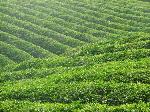
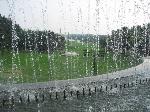
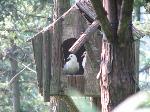
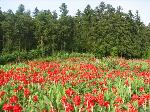
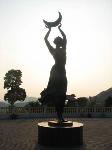
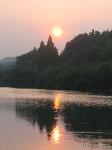

 Copyright © 1998-2025 All rights reserved.
Copyright © 1998-2025 All rights reserved.